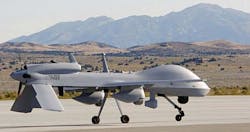Northrop to operate man-hunting airborne radar system for operations in Afghanistan
REDSTONE ARSENAL, Ala., 16 Dec. 2013.Airborne radar experts at the Northrop Grumman Corp. Electronic Systems segment in Linthicum, Md., will continue to operate and support a system designed to detect and follow people traveling on foot, as well as moving land vehicles, under terms of a $65.3 million contract modification announced Friday.
Northrop Grumman will do the work on the U.S. Army's Vehicle and Dismount Exploitation Radar (VADER) system. Awarding the contract were officials of the Army Contracting Command at Redstone Arsenal, Ala. The VADER man-hunting radar is for manned aircraft and unmanned aerial vehicles (UAVs).
The contract calls for Northrop Grumman operate and sustain the VADER system now deployed in theater. The Army has been operating three VADER man-hunting radar systems -- two in Afghanistan and one in the U.S.
VADER can be operated from manned fixed-wing aircraft such as the twin-engine Britten-Norman Islander, on which the company flight-tested VADER in 2008, as well as on the General Atomics MQ-1C Grey Eagle UAV.
VADER is designed to track vehicles and foot traffic over a wide area from UAVs and manned aircraft, and provide Army ground commanders with real-time ground moving target indicator (GMTI) data and synthetic aperture radar (SAR) imagery.
A Tactical Common Data Link (TCDL) transmits VADER data to an exploitation ground station with the remote radar control, mission planning, and exploitation equipment.
Northrop Grumman initially won the VADER development contract in 2006. The project has sponsorship from Joint Improvised Explosive Device Defeat Office (JIEDDO), the Defense Advanced Research Projects Agency (DARPA), and the Defense Microelectronics Activity (DMEA), as well as from the Army Intelligence and Information Warfare Directorate.
VADER's exploitation suite includes the DARPA NetTrack tool for persistent reconnaissance, surveillance, tracking, and targeting of evasive vehicles and people moving on foot in cluttered environments.
The system operates in two modes: as a synthetic aperture radar for high-resolution still images, and as a real-time ground moving target indicator for detecting and tracking moving targets-particularly moving vehicles and humans on foot.
The overall idea of the VADER system is to detect teams planting improvised explosive devices (IEDs) to destroy or damage U.S. military vehicles and personnel. VADER also has been demonstrated to track animals and boats.
The VADER's ground moving target indicators detect the Doppler shift that moving objects produce in radar return signals, Northrop Grumman officials say. Doppler shift is a change in the frequency of the radar return caused by the motion of the target. Because there is no shift caused by stationary objects, the shift reveals moving objects.
VADER transmits processed signals from the aircraft to ground stations, where operators can view still, high-contrast, black-and-white synthetic aperture radar images, or moving targets displayed as dots on a map.
On the current contract Northrop Grumman will do the work in Linthicum Heights, Md., Hagerstown, Md., and Afghanistan, and should be finished by the end of 2014.
For more information contact Northrop Grumman Electronic Systems online at www.es.northropgrumman.com, or the Army Contracting Command at www.army.mil/ACC.

